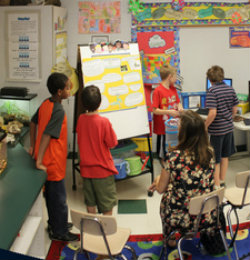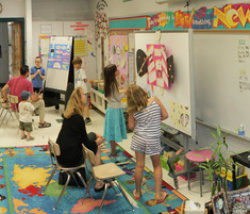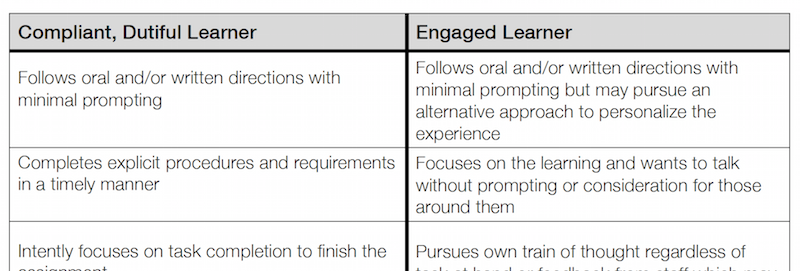Engage Students with Active Learning Ideas
A MiddleWeb Blog
 Take a minute to think about a few of your most recent lessons. What’s happening in your classroom? What are you and your co-teacher doing? More important, what are your students doing?
Take a minute to think about a few of your most recent lessons. What’s happening in your classroom? What are you and your co-teacher doing? More important, what are your students doing?
Are your students engaged? Or are they just being politely compliant? How do you know?
There is the real possibility that there are times when you get caught in the conformity trap (all well-intentioned teachers do sometimes). When we keep our focus zoomed in on our lesson plans, paperwork, parent phone calls, meetings, and other professional roles and responsibilities, we can lose sight of what’s happening in the moments with our students.
But fear not. We have ultimate control. We can make the moments of learning ignite with engagement! So, let’s see what we can do to keep engagement as a natural part of the learning process.
Pause and take a panoramic view
In that mindful moment, see the learning through the perspective of your students. And a minute is all it will take to get you hooked, because the view is spectacular! As long as you are truly honest with yourself, you will learn a lot about your teaching styles and moves.
 As you scan your classroom, ask yourself, What does this tell me about my instructional decisions? How are my co-teacher and I working together to keep each learner in the room meaningfully engaged?
As you scan your classroom, ask yourself, What does this tell me about my instructional decisions? How are my co-teacher and I working together to keep each learner in the room meaningfully engaged?
And now, keeping a keen crystal clear view on your students’ perspective, there’s one more question to ponder as we move deeper into this post: ask yourself, are the students really engaged or are they just being compliant?
Sorting out “compliant” and “engaged”
Let’s begin by taking a look at the distinction between being a compliant student and being an engaged learner (Source: The Competent Classroom LLC and Mindsteps Inc.). As you glance over the differences in this chart, don’t despair if you find that your students often fall in to the compliant zone. Just don’t let them stay there!
Let’s take a look at three broad categories co-teachers should consider when proactively and flexibly planning for student engagement.
Physical Engagement
- Make movement a part of your lessons: Take the age of your students, double it, and use that number as a guide for how many minutes they can sit at a time before they zone out. This rule works like a charm! Learners need to move, stretch, and navigate through an active learning process.
- Cooperative Learning with pizazz!: Check out these Five Strategies to get kids moving! from Resources for Teachers.
- The classroom structure: Consider the layout of your furniture, the artwork, posters, and physical design of your room. Make sure it is conducive to clear, active, organized thinking. Not too cluttered—never too disorganized—and always inviting, accessible, and relaxing.
Social Engagement
 Keep the kids talking: Promote student voice by providing many opportunities for students to first hear their own voice and then share it outloud in small group and whole class activities. When you must present lecture style, make time for interaction and processing. The Three-Minute Pause by Jay McTighe is the perfect way to make any lesson engaging by providing time for students to process and paraphrase as they construct deeper understandings.
Keep the kids talking: Promote student voice by providing many opportunities for students to first hear their own voice and then share it outloud in small group and whole class activities. When you must present lecture style, make time for interaction and processing. The Three-Minute Pause by Jay McTighe is the perfect way to make any lesson engaging by providing time for students to process and paraphrase as they construct deeper understandings.- Co-create a community of learners: I like to say there’s a cooperative learning strategy (Johnson & Johnson) for that! Whenever any teacher is looking for a way to make any lesson more engaging, the process of getting students to connect with themselves and others is always the way to go.
- Student choice: When teachers mix in the freedom of choice, students feel empowered. They begin to trust their own instincts—hear their voice—and become more comfortable sharing what they think with others. Here are 9 Simple Ways to Provide Student Choice in Your Classroom from Ariane Huddleston, teacher of “strong-willed tweens.
Cognitive Engagement
- The Domino Effect: As students become comfortable with the classroom physical structure and design, along with feeling they are part of a learning community, they will be more open to learning the academics. Relaxing and feeling empowered will do that to any learner! So let the intellectual activities begin!
 The basics of active reading strategies: Remember to empower each learner to be in charge of himself. How do you, or could you, adapt and incorporate these active reading strategies (McGraw Center Teaching & Learning) in an upcoming lesson?
The basics of active reading strategies: Remember to empower each learner to be in charge of himself. How do you, or could you, adapt and incorporate these active reading strategies (McGraw Center Teaching & Learning) in an upcoming lesson?- Creating notes: Gone are the days of copying notes in class! That’s at least the headline that I wish made the frontpage of your favorite educational newspaper. Seriously consider this. As students merely copy notes, what are they learning? You guessed it! They know how to sit compliantly…as they rotely…robotically (and sometimes, alas, frantically!) copy what the teacher tells them to write. NO! NO COPYING! Instead, make sure your students are creating, co-creating and putting more thought into note-taking. You don’t learn by just forming words on a page. Check out these 5 Note-taking Methods (ASDS, University of Redlands) This may be my favorite resource in this post! Don’t be put off by the university-level language. You can adapt it, right? Remember: your flexible, adaptive teaching is the power source for active engagement!
In the comments, share one of your teaching moves that you believe creates an active, engaging learning process with your students.
Image credits


































